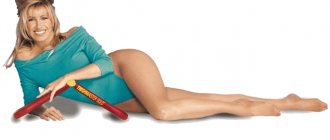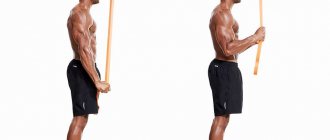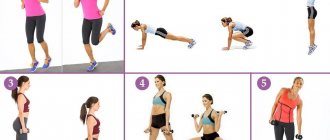Of all the components of physical fitness, stretching is the most overlooked. There is simply not enough time and energy for it. And in vain. Let's look at its benefits, recovery methods and types of stretching for all muscle groups.
Why are recovery exercises important for athletes, how to include stretching exercises in the training process and how to perform them correctly? Most athletes disdain stretching, considering it to be for beginners. The only thing they demonstrate by this is their illiteracy and short-sightedness.
Even if an athlete understands the importance of muscle stretching, many do not have enough time and patience for it, since by the end of a strength or cardio training, the only desire is to take a shower and run home.
Why do you need stretching?
There are many reasons.
For example, oversized muscles are thought to interfere with normal movement, and bodybuilders are extremely inflexible to effectively stretch after strength training. However, this is nothing more than a myth - the smoothness and ease of movements does not depend on the volume of muscles.
Physiology of the process. Your muscles actively contract during cardio or strength training. After completing the workout, the loaded areas of the body remain clamped for a long time. The subsequent gradual restoration of muscle length is called rest. Until the muscle regains its length, it has not rested. To speed up the recovery process, it is most effective to apply a set of stretching exercises to all affected body groups.
Athletes begin to lose flexibility due to lack of appropriate regular exercise. Of course, some people are initially more flexible from childhood, but this is not an excuse. Stretching has a positive effect on any person - from children to the elderly. It is best to stretch regularly, performing special complexes, both before and after training or on rest days.
In addition, stretching in bodybuilding brings many benefits, for example, it perfectly warms up and calms the muscles, and also improves muscle coordination, prevents long-term muscle pain and speeds up recovery. You will feel more energetic and improve your body's capabilities.
Stretching prevents stiffness. Over the years of training without high-quality regular stretching, the athlete’s muscles “remember” their shortened length and get used to it.
Muscle contraction and relaxation are two sides of the same process. As much as it can stretch, it can shrink further. If the muscle has not been stretched, it will contract less well, which will cause stagnation in strength results. We offer a simple set of exercises in a video program.
Also, stretching exercises prevent various injuries. According to statistics, athletes who regularly stretch are half as likely to suffer sprain-related injuries. If these professional guys take stretching responsibly, isn't it time for you to think about it too?
Why do you need to stretch after a workout?
Let's look at why you need to stretch after a workout. After physical activity, the muscles are loaded and exhausted, they are in a state of hypoxia, and may hurt. Thanks to stretching, blood flow is distributed evenly, and decay products are eliminated faster. It helps relieve muscle fatigue and relieve pain. Stretching also helps you recover faster and form the correct shape of your figure.
Why do men need stretching after exercise?
To get maximum results from sports, you need to start, conduct and end your training correctly. Stretching helps increase endurance, strengthens joints, and increases range of motion. If muscles are subjected to high loads, they shorten and thicken over time. In representatives of the stronger sex, they are tough in themselves, which is why strength training gives more tangible results. Due to overstrain and overheating of the muscles, joint mobility may decrease, which reduces the effectiveness of the exercise.
Most men who are not professional athletes exercise in order to gain muscle definition, improve endurance and health. Why does a man need stretching after a workout? It helps release tissue for muscle growth. By stretching, you will again speed up blood flow in your muscles. Lactic acid will begin to leave, the connective tissue will give way to muscle fibers. Stretching helps you relax and provides additional oxygen not only to your muscles, but also to your internal organs. It helps normalize blood pressure, increase the strength of ligaments and joints, and prevent diseases that are accompanied by the deposition of salts in the joints.
In men who stretch after training, arthritis and arthrosis are three times less likely than in those who do not stretch.
Why do girls need stretching after training?
Women for the most part go in for sports not in order to strongly pump up their muscles, but in order to strengthen them, maintain a slim figure and tone the body. Stretching after training for girls helps improve athletic performance, strengthens ligaments and joints, and prevents possible injuries. In addition, such exercises are a great way to improve flexibility, gracefulness and sexuality, and get an attractive figure.
For a woman, muscle shortening will be an aesthetic problem. In addition, this increases the risk of injury due to careless movements or walking in heels. Constant stretching improves coordination, helps repair injured muscles and improve blood circulation, and even improves self-confidence.
During menstruation, it is important for girls not to overdo it with stretching, as it increases uterine contractions and can cause severe bleeding.
When to do stretching exercises
It is best to stretch the muscles after a short warm-up or workout, when they are well warmed up or too tired to resist stretching.
Make it a rule to do the suggested exercises after every strength or cardio workout. Weight training makes muscles hard and inflexible. When working with heavy weights, micro-tears of muscle fibers occur. Within 24-73 hours after training, the body restores them, causing them to become stronger and fuller. By performing appropriate recovery exercises on the day of your workout, you will loosen your muscles and also develop flexibility (provided you do it long enough and often enough).
You can stretch at home in the evening after training. For many active athletes, this is an ideal option, as it does not require special equipment. The more you stretch throughout the day, the more flexible your muscles will be and the easier it will be for you to maintain flexibility in the future.
Proper stretching after strength training
Proper stretching involves holding the position of gentle tension on the muscle (without pain) for 10-30 seconds. This is called light stretching. You should feel comfortable. If you feel discomfort or pain during the exercise, you need to weaken or stop the exercise.
Stretching exercises after training are done statically without sudden body swaying or jerking.
After a delay in the working position, when the muscles have become accustomed to the position of the body, you can begin progressive stretching. From a position of light stretching, you need to gradually move forward until you again feel a slight stretch in the muscle. Hold again for 10-30 seconds. The voltage will decrease slightly. Again, if you feel discomfort or pain in your muscles, you need to ease up to the point of comfort.
Remember to breathe. Breathe naturally while doing the exercises. Do not hold your breath, as this interferes with relaxation and is not beneficial. To avoid sudden movements that cause contraction of muscle fibers, breathe slowly and rhythmically. The exhalation force helps to better relax the muscle and enhances the effect. Additionally, try exercises with a massage roller. They will become indispensable for a deeper study of the fascia.
Incorrect technique
Discomfort or pain means you are stretching incorrectly, such as springing. The body responds better when completely relaxed. Pain and discomfort cause tension. It is better not to stretch through the pain, this can lead to rupture.
conclusions
So, to create a post-workout stretching routine, use the following diagram.
- Mark the target muscle groups that were involved in the workout.
- Choose a stretching exercise for each group.
- Incorporate stretches for muscle groups from the opposite myofascial line to balance the complex.
- Perform each stretching exercise for 90–120 seconds (during this time the fascia has time to get used to the new position).
That's all. If you have your own tips and comments about stretching after a workout, share them in the comments.
Leg stretching complex
Gluteal stretch
- 10-20 seconds
- Body Part: Buttocks Equipment: No
Glute stretch (knee to chest)
- 10-20 seconds
- Body Part: Buttocks Equipment: No
Hip abductor stretch while lying on the floor
- 10-20 seconds
- Body Part: Hamstring Equipment: No
Quadriceps stretch while sitting on your knees
- 10-20 seconds
- Body part: Quadriceps Equipment: Body weight
Quadriceps stretch while kneeling
- 10-20 seconds
- Body part: Quadriceps Equipment: Body weight
Quadriceps Lunge Stretch
- 10-20 seconds
- Body part: Quadriceps Equipment: Body weight
Forward Bend Hamstring Stretch
- 10-20 seconds
- Body Part: Hamstring Equipment: No
Stretch your calf muscles with your palms against the wall
- 10-20 seconds
- Body Part: Calves Equipment: No
Stretching the calf muscles and Achilles tendon
- 10-20 seconds
- Body Part: Calves Equipment: No
Add to Calendar * Add to My Workouts * Print Workout
* — The service is in beta testing
Pay attention to the results: how do your muscle fibers feel, have they begun to recover better and faster?
Basic exercises
For the neck
Gently tilt your head to the sides and forward, gently increasing the pressure with your palm.
For shoulders
Extend your arm parallel to the floor (right to the left, left to the right), with the other hand gently press on the elbow area.
For biceps
Extend your hand forward and turn it palm up. With your other hand, press down on your fingers, pulling them down.
For triceps
Bend your arm at the elbow and place it behind your back. Stretch your fingers down along the spine, with the other hand lightly press on your shoulder.
For the chest
Place your hands back, interlace your fingers, and reach up.
For the obliques
Raise your right arm, tilt your body to the left, stretch to the left. Repeat with the other hand.
For the back and spine
Place your feet shoulder-width apart, bend them slightly, bend down and grab your hips. Stretch your body down. Reach your hands towards your toes, trying to touch them.
For the press
Lie on the mat on your stomach, place your hands in front of you and lift your body up, stretching your abs. Keep your head straight.
For legs
- Lunge forward, tilting your body toward the knee of your supporting leg to stretch the calf and hamstring muscles of the other leg.
- Take a step forward and place your foot on your heel. Shift your weight to your other leg, bend it slightly. Place your hands on your knee and bend down, stretching your hamstrings and hamstrings.
- Bend your leg at the knee, take it back and grab your foot with your hands. Press your foot toward your butt to stretch the quadriceps.
- Take a deep lunge, raise your arms up and stretch your groin muscles.
For thighs and buttocks
Bend your leg at the knee, lift it and press the reed against your stomach. Using your hands, apply pressure to your shin to stretch your hamstrings and gluteal muscles.











